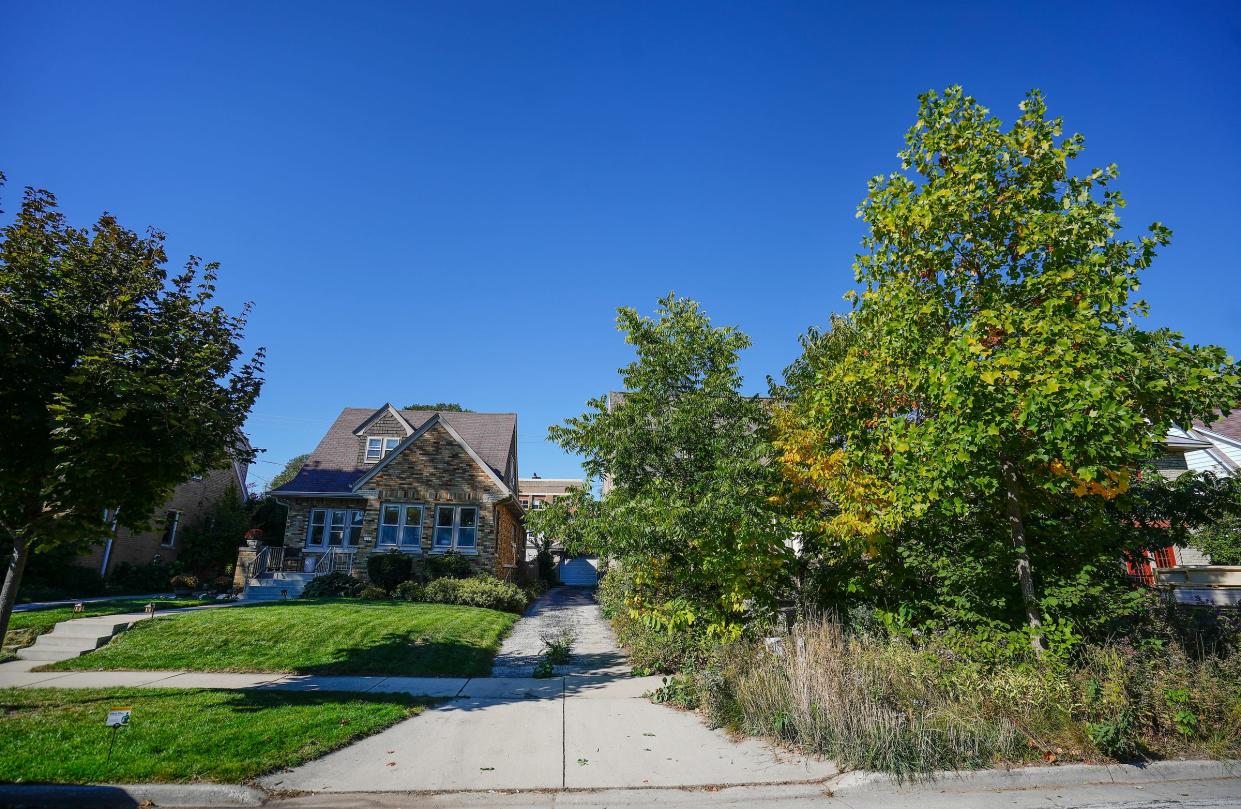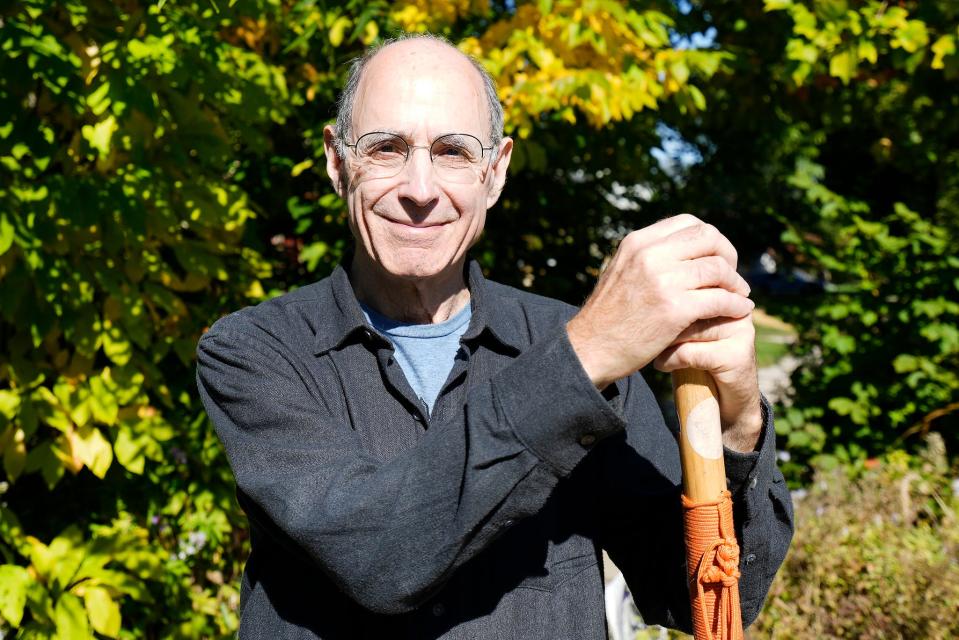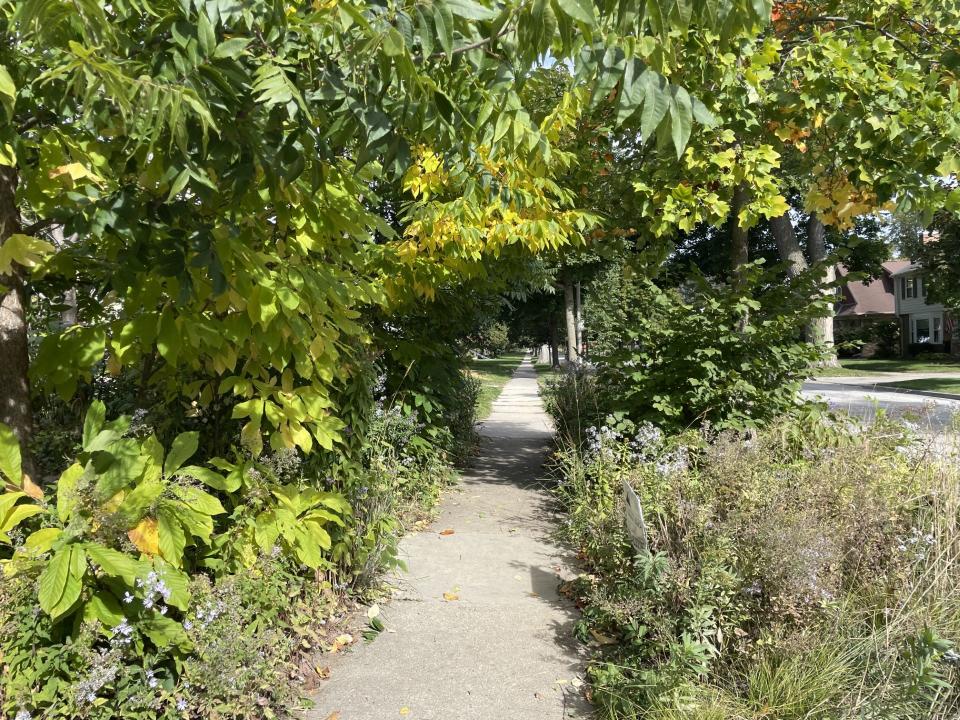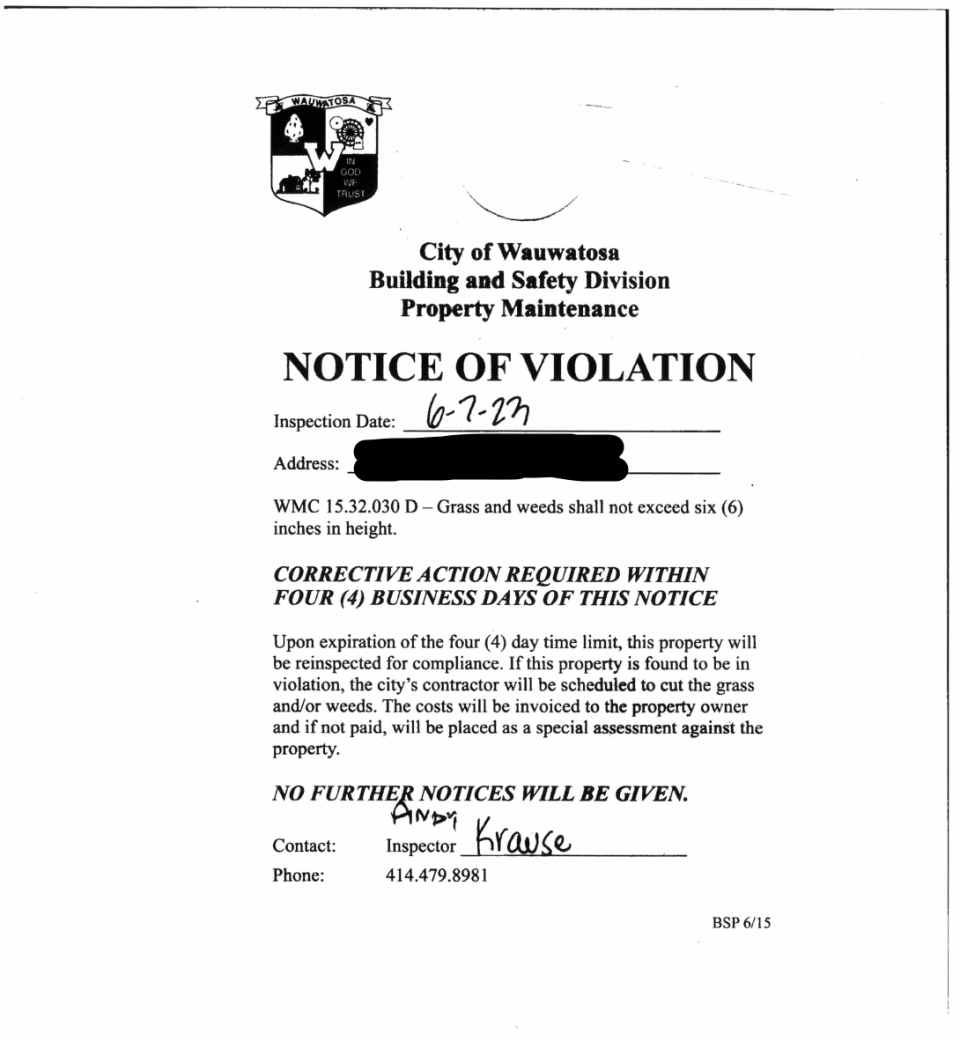Is Tosa man's yard a natural garden or code violation? Wauwatosa officials will discuss.

Ed Sternberg thinks of his Wauwatosa home's front yard as his “outdoor living room.”
Instead of a manicured lawn, his yard and the land between his sidewalk and street teem with tall native plants. Trees shade the space and bear fruits that aren't typically found in suburban yards, like persimmons, pecans, butternut and pawpaw, the largest fruit native to North America. Sternberg even keeps a 25-page document that meticulously details the scientific names of more than 170 plant, tree and shrub species he's planted in his yard and how to care for them.
Sternberg, who has lived in his home for more than 30 years, has cultivated his natural gardens and “pocket forest,” a small urban ecosystem that’s beneficial to pollinators, for eight years. As the garden grows, it attracts neighbors and visitors curious to learn about native plants. It’s been a field trip destination for members of the nonprofit Natural Resources Foundation of Wisconsin to learn about his trees.
Gardening brings him joy and the result brings a calm to his visitors, Sternberg said.

“You can feel them take a deep breath while they’re in the gardens as they look around, and they feel comfortable,” he said.
But Sternberg’s property has also faced criticism that it is too wild and not up to code. A resident complaint to the city in June that the yard is "extremely overgrown" sparked a code violation citation from the city. After Sternberg appealed the citation, the city's Board of Public Works will discuss the yard at an upcoming meeting, bringing up questions over how big natural gardens can grow in Wauwatosa.
The Board of Public Works will discuss the yard in November
Sternberg said he began to plant his natural gardens when both his turf grass lawn and the elm trees on his street were ailing. He attributes the dying grass to poor soil affected by the mixture of gravel and soil that was used by contractors to repair a margin strip between the sidewalk and his house.
After he started to grow the natural gardens, he received some complaints from neighbors that resulted in code violations in 2015 and 2021. In both instances, he said he talked with officials at the city and had neighbors and plant experts send letters to the city in support of his gardens. Both times, when Sternberg asked the city to revoke the alleged violations, he didn't hear anything further from the city on the status of his citations, Sternberg's lawyer Dennis M. Grzezinski wrote in a letter to the city obtained by the Journal Sentinel.
In June of this year, Sternberg received a code violation notice on his front door after a resident filed a complaint to the city that his yard was “extremely overgrown.”
The resident who filed the complaint declined to be quoted by the Journal Sentinel for this story, but the complaint says “you can barely see the house from the street and people cannot walk on the sidewalk passing the house without getting scratched by the branches."
The notice said Sternberg had four business days to rid his yard of the grass and weeds taller than six inches or the city’s contractor would cut the lawn and invoice him for the service, per Wauwatosa municipal code 15.32.03 D. 3.
Sternberg told the city his yard does not violate the code. He maintains his natural gardens multiple times a day and has no grass or weeds to cut, he said.
Working with a lawyer, Sternberg appealed the violation and the city set a hearing with the Board of Public Works for Sept. 18, following municipal code.
City of Wauwatosa sent an email to Sternberg on Sept. 14
Wauwatosa's building and safety manager Stefanie Escobedo notified Sternberg in an email Sept. 14 that the city would delay the September hearing so that a landscape architect could have more information on his yard.
She additionally noted that "planting in the city's right-of-way is not permitted" and that Sternberg would have to submit an encroachment application and landscape plan in order to have his matter reviewed by the Board of Public Works. The right of way is the space between the property line and the edge of the street pavement which property owners are responsible for maintaining, according to Wauwatosa's municipal code. An encroachment application has a $100 fee that can be waived by the Board of Public Works according to municipal code.

Officials now plan to discuss Sternberg's yard, including whether he should remove landscaping longer than 6 inches in his property's right of way, at the Board of Public Works meeting Nov. 6 at 8:30 a.m.
In the Sept. 14 email, Escobedo asked Sternberg to provide "a detailed landscaping plan of both your property & the Right-of-Way" by Oct. 14 for a landscape architect's review ahead of the Nov. 6 Board of Public Works hearing.
Eva Ennamorato, Wauwatosa communications specialist, confirmed Monday that the city extended Sternberg’s deadline to submit a lawn plan to October 20. She also said Sternberg needs to submit an encroachment application, which has a $100 fee that can be waived by the Board of Public Works, as other residents with similar vegetation have according to municipal code.
If the Board accepts Sternberg's landscape plan at the November meeting, the grass citation Sternberg received in June would be resolved without any fees, according to Ennamorato. The Board will also discuss the plantings in Sternberg's right of way, she said.
Sternberg said he’s not sure he will make the Friday deadline to submit a landscape plan. He said he feels the city is attempting to "paper over" earlier mistakes with code enforcement and that the process has brought on “difficulty, pain and needless cost."
He also argues the city never served him an official code violation regarding the gardens in question on his right of way, which are written under Wauwatosa municipal code 12.06.010 A.
Ennamorato confirmed to the Journal Sentinel that the city only has record of the code violation relating to long grass and none related to the maintenance of Sternberg's right of way as cited in 12.06.010 A.

Neighbors are showing support for his cause, Sternberg says
Since he received the code violation citation in June, Sternberg has received support from his neighbors. Some have written letters to the city backing him and his gardens, he said. He hosted a field trip for 12 members of the Natural Resources Foundation of Wisconsin, and 11 people were on the waitlist, according to the nonprofit.
“In one sense, it’s a relief to know in writing that the city is no longer threatening to mow my thirty-foot trees,” Sternberg said in regard to the city's request for a landscape plan to resolve the matter. “The fact that I’m living in a city where it can at its own will initiate a process like that is deeply disturbing.”
Sternberg and his lawyer are asking that the city dismiss its code citation against the lawn, strengthen its municipal code to avoid similar situations for others who grow large-scale natural gardens and reimburse Sternberg for the expenses he’s paid to resolve the issue.
The city says all that's needed is the paperwork detailing Sternberg's gardens so the board can approve them in November.
“We don’t want to delay this, as we allow natural landscaping following a city approval process,” Ennamorato said in an email to the Milwaukee Journal Sentinel. “We simply need an encroachment application and landscaping plan which can be hand-drawn."
The national culture around landscaping is shifting, ag professor says
Native plants like those in Sternberg’s gardens improve biodiversity and are resilient in extreme conditions like Wisconsin’s recent droughts, Amy Staffen, an ecologist with the Wisconsin Department of Natural Resources told the Journal Sentinel in August.
As communities experience the impacts of climate change, the national culture around landscaping is shifting, according to Doug Tallamy, the founder of homegrownnationalpark.org and a professor of agriculture at the University of Delaware.
“There is not enough nature out there to produce the life support that we all need,” he said. “Eliminating the natural systems that support us is not an option.”
But even as cities like Wauwatosa allow native landscaping in their codes and encourage sustainability initiatives like No Mow May, discussions and disagreements over the aesthetics and size of gardens natural gardens are common, and happening around the country, Tallamy said. A couple in Maryland sued their homeowner association when they were ordered to change their natural gardens with landscaped grass. They won the case, changing the state's law.
Tallamy thinks residents can compromise and maintain gardens in a way that combines natural gardens and the traditional landscaping some neighbors prefer. He said it could be a small strip of grass along the sidewalk or driveway that serves as a marker to ensure that there's no confusion about where the gardens start.
Tallamy said education and conversations between local government and residents planting native plots can help ease tensions.
“Educate the townships, so that they're more tolerant of natural plantings and the people putting in the natural plantings so that they don't cause the conflicts,” he said.
In Milwaukee, for example, city ordinances state that no grass or weeds can be taller than seven inches, similar to Wauwatosa's six-inch grasses rule. When tall grass or weed-related complaints are submitted to the City of Milwaukee, urban forestry technicians who are educated on how to identify native species respond, according to Tiffany Shepherd, marketing and communications manager at the City of Milwaukee's Department of Public Works. Technicians will not cite a property due to differing aesthetic preferences between neighbors, she said.
Here's what municipal code states in Wauwatosa regarding natural gardens and landscaping:
15.32.03 D. 3. – Whenever grass or lawn weeds on properties are six inches or more in height, or if noxious weeds are present, or if the overgrowth of vegetation is such as to cause a seriously blighting influence, the city may order the condition corrected within four days or other time limit set forth by the safety and building division. Orders to correct shall not be issued on grass in excess of six inches in the month of May. If the condition is not corrected within the specified time limit, the code enforcement officer is empowered to cause such grass, weeds and overgrowth of vegetation to be cut, and the cost therefore shall be placed on the tax rolls as a special charge against the property.
12.06.010. A – In accordance with the provisions of Section 12.04.040A, the abutting property owner is responsible for maintaining the street right-of-way between his property line and the edge of the street pavement including weed cutting or removal.
15.32.010 – "Natural garden" means a wildflower, prairie, woodland or other decorative garden border or area that is under one acre in square footage which is well maintained, is not a public nuisance or a serious blighting influence and contain no noxious weeds.
Contact Bridget Fogarty at bfogarty@gannett.com.
More: Wauwatosa again considers limiting how high some commercial buildings can be
More: Brookfield East principal is one of three finalists for National Principal of the Year
Our subscribers make this reporting possible. Please consider supporting local journalism by subscribing to the Journal Sentinel at jsonline.com/deal.
DOWNLOAD THE APP: Get the latest news, sports and more
This article originally appeared on Milwaukee Journal Sentinel: Wauwatosa home's natural gardens raise questions about code

